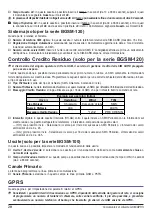
BGSM-100/120
33
G
G
G
G
G
STATUS LEDS
There are 5 LEDs on the PCB (see Figure 4): three green LEDs (L1, L2 and L3), one yellow LED (L4) and one red LED (L5).
These indicate the connection, transmission, malfunction conditions and, for the BGSM-120 series only, the Communicator
status (see table 2).
,
,
,
,
,
During initialisation and the programming phase, the LEDs flash.
RED — This LED is normally OFF. It indicates malfunctioning by flashing in the event of trouble. On power-up, this Device
will check for certain trouble conditions to be met in the order listed below. The most significant malfunctioning status
will be indicated, with the corresponding number of flashes of the RED LED (L5), (see below for number of flashes and
malfunctioning indication priority).
YELLOW —
This LED will switch ON when the interface switches to the GSM Network (due to land line trouble or the lack
of this line). If it flashes slowly, it indicates that a call is taking place on the GSM network (both incoming and outgoing).
If lit steadily along with the red LED, this indicates that the default manufacturer data is loading.
GREEN —
The three green LEDs (L1, L2 e L3) indicate the GSM signal strength and status (Table 2), as illustrated in Figure 4:
The first LED
(L1) near the fixing hole. If this LED is OFF, the GSM Network service is unavailable
(NO SERVICE)
. If
this LED is ON, the GSM Network recepetion is weak but sufficient to manage all telephone communications.
The second LED
(L2). When this LED is ON, the reception is good. This LED will switch ON only when the first GREEN LED is ON.
The third LED
(L3). When this LED is ON, indicates excellent GSM signal strength; it only illuminates when the first and
second LEDs are already ON.
Indication priority
Type of malfunction
Red LED flashes
1 (HIGH)
Firmware problem (incorrect firmware)
1
2
Power supply problem
2
3
GSM module problem
3
4
SIM problem
4
5
GSM reception problem
5
6
GPRS problem
6
7
Receiver not available
7
8 (LOW)
Monitoring receiver not detected (receiver 1)
8
No Troubles
Off
Fig. 4 - Operation indicator LEDs
















































